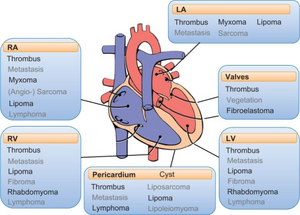Papillary fibroelastoma
| Papillary fibroelastoma | |
|---|---|
| Other names: Benign neoplasm of intrathoracic organs[1] | |
 | |
| Diagram of location of masses in the heart, showing location of fibroelastoma | |
| Symptoms | None, heart failure, feeling faint, chest pain, shortness of breath, sudden cardiac death[1] |
| Usual onset | 60-70-years of age[1] |
| Diagnostic method | Medical imaging: transesophageal echocardiography[1] |
| Frequency | Uncommon[1] |
A papillary fibroelastoma is a primary tumor of the heart that typically involves one of the heart valves.[1] Symptoms vary with size and location of the tumor.[1] There may be no symptoms, when it may be detected when investigating another problem, or there may be symptoms of heart failure, feeling faint, chest pain, shortness of breath and sudden cardiac death.[2] There may be one tumor or many.[1]
The aortic valve is most frequently affected, followed by the mitral valve, tricuspid valve and pulmonary valve.[2] Diagnosis is by medical imaging; transesophageal echocardiography.[1] When looked at by direct visualisation or on imaging, it appears like a "sea anemone".[3] The tumor may appear similar to cardiac myxoma, infected or non-infected vegetations, strands of heart valve, calcification and fibrin strands on valves.[1]
Although uncommon itself, it is the most frequent type of primary heart tumor.[1] The tumor has been reported in all age groups, but typically 60-70-years of age.[1]
Signs and symptoms
Outflow obstruction or embolism can be associated with syncope,[1] chest pain, heart attack, stroke and sudden cardiac death.[1]
Symptoms due to papillary fibroelastomas are generally due to either mechanical effects of the tumor or due to embolization of a portion of the tumor to a distal organ. In particular, chest pain or syncope may be due to transient occlusion of the left main coronary artery by the tumor,[4] while a heart attack or sudden cardiac death may be due to embolization of a portion of the tumor into a coronary artery.[5]
Diagnosis

Papillary fibroelastoma are typically found and accurately diagnosed by imaging. The diagnosis is confirmed by pathology. Histologically, papillary fibroelastomas have branching avascular papillae, composed of collagen, that are covered by endothelium.[citation needed]
Treatment
If the tumor is found incidentally in an asymptomatic person, the treatment approach is controversial. Certainly a conservative approach is warranted in certain individuals.[6] If the tumor is large, greater than 1 cm in asymptomatic patients,[7] and pedunculated, a case may be made for surgical excision prior to symptoms developing due to the higher risk of embolism. However, this is still considered controversial.[8]
If the papillary fibroelastoma is associated with symptoms, surgical excision is generally recommended for relief of symptoms.[6] A minimally invasive approach may be possible if the tumor involves the aortic valve[9] or right atrium.[10] In the case of aortic valve involvement, excision of the tumor is often valve-sparing, meaning that replacement of the valve with a prosthetic valve is not necessary. Repair of the native valve with a pericardial patch has been described.[11]
References
- ↑ 1.00 1.01 1.02 1.03 1.04 1.05 1.06 1.07 1.08 1.09 1.10 1.11 1.12 1.13 WHO Classification of Tumours Editorial Board (2021). "3. Tumours of the heart: papillary fibroelastoma". Thoracic Tumours. Vol. 5 (5th ed.). Lyon (France): World Health Organization. pp. 230–232. ISBN 978-92-832-4506-3. Archived from the original on 2022-05-14. Retrieved 2022-07-22.
- ↑ 2.0 2.1 Devanabanda, Arvind Reddy; Lee, Lawrence S. (2021). "Papillary Fibroelastoma". StatPearls. StatPearls Publishing. PMID 31751019. Archived from the original on 2021-04-14. Retrieved 2022-07-22.
- ↑ Maleszewski, Joseph J.; Basso, Cristina; Bois, Melanie C.; Glass, Carolyn; Klarich, Kyle W.; Leduc, Charles; Padera, Robert F.; Tavora, Fabio (April 2022). "The 2021 WHO Classification of Tumors of the Heart". Journal of Thoracic Oncology: Official Publication of the International Association for the Study of Lung Cancer. 17 (4): 510–518. doi:10.1016/j.jtho.2021.10.021. ISSN 1556-1380. PMID 34774791. Archived from the original on 2022-07-24. Retrieved 2022-07-24.
- ↑ Kalavakunta, Jagadeesh K.; Martin, David; Gupta, Vishal (2011-01-01). "A rare location and presentation of papillary fibroelastoma". The American Heart Hospital Journal. 9 (2): 114–115. doi:10.15420/ahhj.2011.9.2.114. ISSN 1541-9215. PMID 24839649.
- ↑ Takada A, Saito K, Ro A, Tokudome S, Murai T (2000). "Papillary fibroelastoma of the aortic valve: a sudden death case of coronary embolism with myocardial infarction". Forensic Sci Int. 113 (1–3): 209–14. doi:10.1016/S0379-0738(00)00207-3. PMID 10978627.
- ↑ 6.0 6.1 Mutlu H, Demir IE, Leppo J, Levy WK (2008). "Nonsurgical Management of a Left Ventricular Pedunculated Papillary Fibroelastoma: A Case Report". J Am Soc Echocardiogr. 21 (7): 877.e4–7. doi:10.1016/j.echo.2007.10.001. PMID 18191538.
- ↑ Gopaldas, R. R.; Atluri, P. V.; Blaustein, A. S.; Bakaeen, F. G.; Huh, J.; Chu, D. (2009). "Papillary Fibroelastoma of the Aortic Valve: Operative Approaches upon Incidental Discovery". Texas Heart Institute Journal. 36 (2): 160–163. PMC 2676606. PMID 19436815.
- ↑ Boodhwani M, Veinot JP, Hendry PJ (2007). "Surgical approach to cardiac papillary fibroelastomas". Can J Cardiol. 23 (4): 301–2. doi:10.1016/S0828-282X(07)70759-6. PMC 2647888. PMID 17380224.
- ↑ Hsu VM, Atluri P, Keane MG, Woo YJ (2006). "Minimally invasive aortic valve papillary fibroelastoma resection". Interact Cardiovasc Thorac Surg. 5 (6): 779–81. doi:10.1510/icvts.2006.133702. PMID 17670711.
- ↑ Kim RW, Jeffery ME, Smith MJ, Wilensky RL, Woo EY, Woo YJ (2007). "Minimally invasive resection of papillary fibroelastoma in a high-risk patient". J Cardiovasc Med. 8 (8): 639–41. doi:10.2459/01.JCM.0000281694.01986.ab. PMID 17667039.
- ↑ Westhof FB, Chryssagis K, Liangos A, Batz G, Diegeler A (2007). "Aortic valve leaflet reconstruction after excision of a papillary fibroelastoma using autologous pericardium". Thorac Cardiovasc Surg. 55 (3): 204–7. doi:10.1055/s-2006-924439. PMID 17410513.
External links
| Classification |
|---|